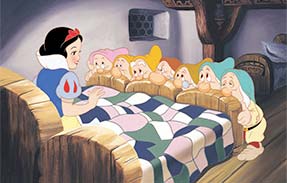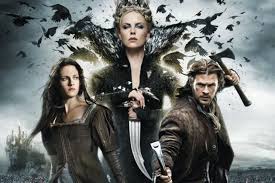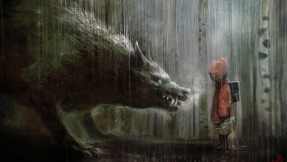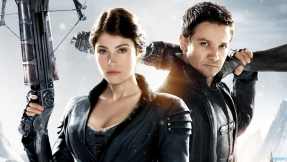Fairy tales: How They Have Changed Over Time
Everyone throughout their childhood is usually told the classic fairy tales that install a sense of morals in the child e.g. Beauty and the Beast is the story of a young earl being transformed into a beast and his servants to household items for his selfishness in rejecting an old beggar shelter for the night. After the Beast captures Belle’s father for trespassing she offers herself in his place and over time begins to fall in love with the Beast and with true love’s kiss the beast transforms back into the handsome young earl along with his servants back to themselves and they all live Happily Ever After. The moral of this story being ‘Don’t Judge a Book by its Cover’ as the old beggar was in-fact an old witch and obviously the Beast was actually an earl. But these tales are more recently becoming something for adults with a child at heart to indulge in. Looking over some of the cinematic adaptions of these fairy tales there seems to be a tried and tested method to a good fairy tale film/television show, whether it’s aimed at children or adults that can draw emotions out of the strongest men. Fairy tales have changed throughout the ages, and seem unrecognizable when compared to the originals, so let’s look at the differences:
Snow White

Snow White is possible the most notable of fairy tale, it’s the story of an Evil Queen who is jealous of her beautiful step-daughter and orders a huntsman to kill her. After the huntsman is unable to go through with killing Snow, she runs throughout the forest and finds a cottage. Once she has eaten from the kitchen of the cottage, she falls asleep, only to be found by seven dwarfs who take pity on her and agree that she can stay with them as long as she cooks and cleans for them. After hearing that the huntsman has betrayed her from her magic mirror, the Evil Queen takes matters into her own hands and decides to find and kill Snow White herself. After disguising herself as an old beggar the Evil Queen gives Snow White a poisoned apple and Snow falls into a deep sleep only to be woken by a handsome Prince and they live happily ever after.

In the original Brothers Grimm tale, the above isn’t the end of the story as the Evil Queen unknowingly is invited to Snow White and Prince Charming’s wedding. Once she arrives at Snow White’s big day, hot iron shoes are placed in front of her and for her crimes against the Young Queen she is forced to the step into the burning shoes and dance until she drops dead, a much darker ending than is seen in the 1937 Disney film, Snow White and the Seven Dwarfs. The Disney film adds a child-like wonder to the tale with the dwarfs each being named and therefore having their own personalities; Doc, Grumpy, Happy, Sleepy, Bashful, Sneezy and Dopey. Also in variation to the original tale the Prince and Snow White had met previously to her poisoning as well as the fact that Snow White wakes up immediately wakes up after the Prince has kissed her. The 2012 film Snow White and the Huntsman added a new element to the already fruitful tale with the Huntsman being bargained into returning Snow White to the Evil Queen on the promise that she (The Evil Queen) will bring his wife back from the dead, and upon realizing that this was an empty promise decides to become Snow’s mentor in teaching her how to strike against the Evil Queen.
The moral of the story hasn’t changed over time: good will win in the end over evil, however the character of Snow White has changed from the hapless girl to the empowered female, flowing with the times and the audience.
Little Red Riding Hood

Little Red Riding Hood is the tale of a young girl who wears a red cloak/cap. The girl walks through the woods to deliver food to her sickly grandmother. A mean wolf wants to eat the girl, and the food in the basket. He secretly stalks her behind trees and shrubs. He approaches Little Red Riding Hood and she naively tells him where she is going. He suggests the girl pick some flowers, which she does. In the meantime, he goes to the grandmother’s house and gains entry by pretending to be the girl. He swallows the grandmother whole, and waits for the girl disguised as the grandmother. When the girl arrives, she notices that her grandmother looks very strange. Little Red then says, “What a deep voice you have…” etc. Leading up to the wolf jumping out of bed and swallows her up too, then he falls fast asleep. A lumberjack/hunter, however, comes to the rescue and with the axe cuts open the wolf at which point Little Red and her Grandmother emerge unharmed.
In the earliest version of the tale, the antagonist isn’t always a wolf, but sometimes an ogre or werewolf. As well as the wolf leaves the grandmother’s blood and meat for the girl to eat, who then unwittingly cannibalizes her own grandmother… pretty Grimm huh? (I couldn’t resist). In 2005, the tale took a dark turn with the release of Hard Candy. The film focuses on a 14-year-old vigilante (Ellen Page) who captures and tortures a suspected sexual predator (Patrick Wilson). It turns the tables on the traditional victim that is Little Red as implies that she is both the hunter and the hunted. Hoodwinked! (2005) is a computer-animated family comedy where by the original tale takes a more modern turn with the wolf working along side Little Red to capture Boingo the bunny rabbit and hand him over to the Happily Ever After Agency. Red Riding Hood (2011) tells the tale in an alternative way with the darker side of the tale being looked into. It is the tale of adultery, revenge and love with elements of self-sacrifice by Peter, the love interest of Valerie (Little Red).
The tale holds the morals of not trusting a stranger and that not everything is as it seems which still seems to be the main theme throughout and so far the character of Little Red Riding Hood alternates between both the victim and the predator.
Hansel and Gretel
Hansel and Gretel is the tale of the children of a poor woodcutter. When a famine settles over the land, the woodcutter’s abusive second wife takes the children into the wood and leaves them alone so that she and her husband won’t starve to death because the children eat too much. The woodcutter reluctantly agrees to the plan but Hansel and Gretel overhear their scheme and Hansel sneaks out to find as many white pebbles as he can so that once they are taken to the woods they can leave the pebbles behind them as a trail so that they can find their way home again. Upon their return their stepmother orders the woodcutter to take them further into the woods and Hansel tries to venture out again to find more white pebbles but the doors are locked and he finds it impossible to escape their parent’s house. When the family trek into the woods the next morning Hansel takes a slice of bread and leaves breadcrumbs in their wake to find their way home again but they are eaten by birds and the children are left lost in the woods. After days of searching they come across a house made entirely from gingerbread and cakes. Hungry and tired the children begin eating the roof, the door opens and an old woman lures them inside with the promise of soft beds and all the food they can eat. The next morning the old woman who is actually a wicked witch who plans to cook and eat the children lock Hansel in a cage and forces Gretel to become her slave. Hansel is regularly fed by the witch to fatten him up but Hansel cleverly holds out a bone from the cage (presumably an old victim of the witch’s) and due to her blindness the witch thinks it’s a finger and is fooled into thinking that he is too thin to eat. After weeks of this, the witch grows tired and decides to eat him whether “be he fat or lean.” She prepares the oven for Hansel but decides she is hungry enough to eat Gretel. She coaxes Gretel to the oven to see if the fire is hot enough. Gretel realizing the witch’s plan pretends to misunderstand what the witch is asking of her and the witch growing impatient demonstrates and leans over the front of the oven and which point Gretel pushes her in and the witch dies. Gretel frees Hansel from his cage and the pair discover a vase full of treasure and precious tones. Putting the jewels in their clothing, the children set off for home. A swan ferries them across an expanse of water and at home they find only their father; his wife having died of unknown causes. Their father spent all his days lamenting the loss of his children and is delighted to see them safe and sound. With the witch’s wealth, they all live happily ever after.
Hansel and Gretel is a story that until recently has not changed dramatically. The characters of Hansel and Gretel can be seen in Hoodwinked Too! Hood vs. Evil (2011) when they are kidnapped by an evil witch and Little Red and her partner, Wolf W. Wolf are sent by the Happily Ever After Agency to save them, in a plot twist they turn out to be the film’s protagonist and defeated in the end when Little Red and Wolf trick them into eating more candy and they grow so big they become wedged between two buildings and are arrested soon after.

Hansel and Gretel: Witch Hunters (2013) is primarily set fifteen years after the siblings ordeal at the witch’s gingerbread house. It shows the Hansel (Jeremy Renner) and Gretel (Gemma Arterton) have grown up to become famed bounty hunters dedicated to mercilessly eradication witches, slaying over 600 of them. Their work is relatively easy because, for an unknown reason, they are immune to spells and curses. Hansel however is diabetic as a result their time in the gingerbread house and has to take a regular shot of insulin every few hours (a reoccurring factor throughout the film). In their search to kill Muriel the film’s main antagonist, they discover that there are also good witches in the world who want to help and that (SPOILER ALERT) their mother was one of them, hence they’re immunity to spells and curses. This allows the characters to take a look at themselves even as the film’s protagonists that maybe there is more than meets the eye to the world of magic. This story delves into the adult world of violence, bad language and revenge but there are still the strong classic fairy tale moral of good prevailing over evil. The characters of Hansel and Gretel in this film represent what happens after the inciting incident that is their fairy tale which brings a new interpretation to the classic tale.
Once Upon a Time

Once Upon a Time (2011-present) is an American fairy tale drama. The show takes place in the fictional seaside town Storybrooke, Maine, in which its residents are actually characters from various fairy tales that were transported into the ‘real world’ town and robbed of their real memories by a powerful curse, cast by the Evil Queen in revenge against Snow White and Prince Charming. The reason this television show is relevant and it is contains the largest amount of fairy tale characters in one place and all of their tales are entwined like never before, for example (SPOILER ALERT) the character of Rumplestiltskin is not only the powerful imp-like creature who can spin gold from straw but is also the Beast from Beauty and the Beast and the crocodile from Peter Pan. These new adaptions breathe life into old tales and whilst we remember the old tales well it’s nice to re-experience the sense of wonder and awe that comes with such a show as it’s plot twists are both plausible and surprising.
Fairy tales are one of the first literary things we learned as children to install a sense of wonder and morals. These fairy tales should stick with us throughout life, we all need to be reminded of our youth either in times of need or of joy and to stick with us these fairy tale need to adapt for the adults who want to be reminded of their childhood.
What do you think? Leave a comment.











Good article. If I recall correctly, in some of the older versions of Little Red Riding Hood, the wolf eats the girl, end of story. The moral being don’t trust strangers. I guess you didn’t mention The Little Mermaid, because you were just looking at Grimm’s Fairytales. However, the original version is certainly a lot darker and heartbreaking than the Disney version. Interestingly enough, there is a 1968 Russian animated film, Rusalochka, which follows the Hans Christian Anderson tale far more closely. It’s worth looking up on Youtube.
I didn’t exclude The Little Mermaid, it was just that the above fairy-tales span throughout literature, film and television therefore allowing the discussion of all three mediums but thank you for the feedback.
I enjoyed your article. I remember back when I was about seven or eight years old watching some kind of generic cartoon show with my grandmother. On this particular episode, a few different classic fairy tales were showcased. Of course, the scene with Hansel and Gretel pushing the old witch in the oven played out and I could hear my grandmother saying, “Oh my!” Later we watch the bow break and the baby go tumbling down to the hard earth; again, I heard my grandmother’s appalled voice, “Oh my! these are certainly violent cartoons for children, aren’t they?!” She was right. I would never tell my son the story of the little girl in the red hood who was tricked into eating her grandmother! They are too violent and if not violent, then too twisted for children. Some people (mostly parents) get in a huff because they do not understand why anyone would make such violent tales for children, but it turns out that the Grimm brothers never intended for the audience of their grotesque fairy tales to ever be children in the first place. They brothers originally targeted an adult audience, but for some strange reason, children were attracted to the violent tales more than adults were. The fairy tales seem to make more sense when one knows who they were intended for. I have to say, for a person that enjoys dark horror films. I would not mind seeing the real story of Little Red Riding Hood being played out on the big screen and having the bejesus scared out of me. Thanks for the entertaining article!
Hey! I came across this article and your comment in some research. I am currently writing a research paper on the inteded audience of fairy tales and I found your comment very helpful and interesting. I was wondering, do you know of any books or websites that maybe you found your info from or that might be helpful to me? Thanks!
Strong article but I can’t bare Once Upon a Time. The writing is BAD. From implausible story elements to plot holes to middle-school- caliber creative writing content, I can feel brain cells committing hari kari halfway through every episode that I endure for the sake of my wife.
We know that many fairy tales changed when Disney got a hold of them! Yeah, way too many fairy tales have been sanitized. The ones that couldn’t be cleaned up were ignored by popular culture.
Fairy tales have really changed tremendously throughout time, particularly with the Brothers Grimm Tales. Many of the Brothers Grimm Tales were quite violent and disturbing (especially since many tales dealt with cannibalism), but most of them were sanitized over the years.
In many fairy tales of today, you don’t see a lot of violence to the tales and they are more politically correct nowadays.
Really good article. Takes me back to when I studied fairy tales at university. I don’t really go for the “grown-up fairy tales” that Hollywood keeps churning out because I don’t find them all that entertaining. They all seem to just follow the trend of actionized, forbidden love angles. Once Upon a Time is good because it tries lots of new things. I think some of my favourite modern-day fairy tales are things like Pan’s Labyrinth and Coraline. They borrow some fairy tale elements but put a fresh spin on other things.
Really enjoyed reading this, thank you.
Good Article their are lots of these adaptions of classic fairy tales nowadays, and Once Upon a Time is even getting a spinoff leading to more fairy tales on TV.
This was so intresting! even though we grow up and move on to other literature in a sense fairy tales are still such an important part of our livesm and its really great that they’re being re-explored in film
Interesting topic!
It reminded me of Joel Pommerat, a popular French playwright and director, who focuses on the deconstruction of fairytales by grounding his characters in our daily routine, with car traffic and train strikes. They are mature, lucid and prosaic, deeply rooted in reality.But the magic is preserved through amazing stage effects, and a breathtaking use of lighting, smoke, colours, voices and music.
http://www.actualitte.com/images/actualites/cendrillon-pommerat.jpg
http://artsetregards.files.wordpress.com/2011/11/cendrillon_5_ciciolsson3.jpg
http://www.frequence-sud.fr/admin/transfert/data/15918.jpg
Good article. I am always amazed by the various ways these fairy tales are “updated”, albeit sometimes misguidedly, to seem more relevant to society.
There are also a great deal of sexual undertones to many of the fairy tales. Things that would go unnoticed to the great majority of children and even a great many adults. Obviously, in the case of Little Red Riding Hood there is the predatory aspect of the wolf. But I once read an article (many years ago, my apology for not being able to cite the source), which discussed the Frog Prince, and that the image of the frog was a flaccid phallus, while the image of the prince was an erect phallus, and the catatlyst for transformation, specifically the kiss, represented the willingness of the young woman to indulge in oral sex.
What an interesting read! I think I remember reading somewhere that in the original “Little Mermaid” the mermaid dies and turns into sea foam at the end.I can see why Disney changed it!
I feel that fairy tales have definitely evolved as time went on, but I also feel that children are easily influenced. A “happy ending” where the characters change their ways or do the right thing and live happily ever after is a much better ending than the characters dying or having an unhappy ending despite their positive actions. It instills a sense of hope that can carry on to everyday life. Even today, I watched the first Shrek movie (although that is more of a parody of fairy tales) and it instilled a positive feeling to see that even the “big stupid ugly ogre” could win the love of the princess. All in all, I’d rather have the happy endings over the dark original endings but I can see why people would want to keep the original endings also.
I love fairy tales
I love books
wow thanks guys you really got into detail
meu cu meu cu meu cu meu cu meu cu meu cu meu cu
This was a very helpful article for an essay I had to write for school. And thanks to all of the people who commented you were also very helpful in this task. Like others said I would enjoy this better if it did include the Little Mermaid that is a childhood favorite of mine. Once again thanks a lot!😀
How did the assignment go?